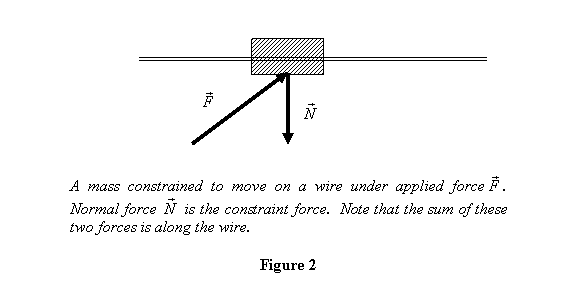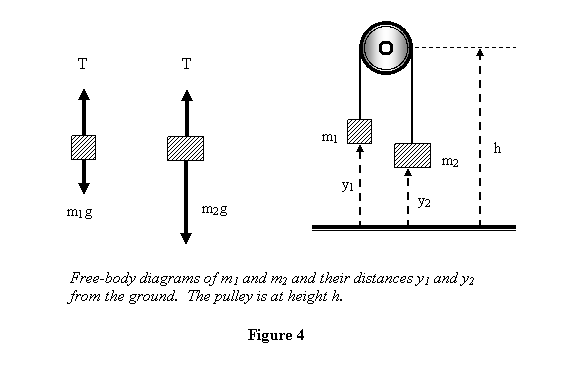Let us start with the example of a mass on a straight
wire (say in x direction). The constraint that the mass
moves only in the x-direction is equivalent to saying
that

This is how we mathematically express the constraint that
the mass moves only along the x-axis. As pointed out
earlier, to keep the y and the z coordinates of the mass
unchanged, the wire applied a normal force on the mass
to cancel the perpendicular (to the wire) component of
the applied force so that the net force is along the
wire. This normal reaction is the constraint force (figure
2). Notice that all that the wire does to the mass, as
far as its motion is concerned, is represented by this
force.

.
To study the motion of the mass all I need to look at
are only the forces – external and constraint forces
- acting on the mass. In this case the wire is represented
by the normal force that it applies. Recall from lecture
4 that such a diagram is called a free-body
diagram . The advantage of drawing a free-body diagram
is that it identifies the relevant quantities to write
the equation of motion. In the present case the free-body
diagram of the mass is given in figure 3.

Let us now write the equations of motion for the body
in terms of its x, y and z -components
:

Let us count how many unknown are there? The unknowns
are x , y , z , Ny , and Nz ,
numbering five ( is
given). But there are only three equations. How do we
find the other two equations? For this recall that the
two of the unknowns, Nx and Ny ,
arise because of the constraints. And it is these constraints
that provide the two more equations needed for a solution.
The constraints that y = constant and z
= constant
imply that is
given). But there are only three equations. How do we
find the other two equations? For this recall that the
two of the unknowns, Nx and Ny ,
arise because of the constraints. And it is these constraints
that provide the two more equations needed for a solution.
The constraints that y = constant and z
= constant
imply that

With these two additional equations, we now have five
equations and five unknowns. Thus and we can solve for x , y , z and Nx and Ny in
terms of given parameters of the problem.
Let us now look at the other problem of two masses hanging
on the sides of a frictionless pulley (see figure 1),
a special case of Atwood's Machine. For simplicity we
take the pulley and the rope to be massless. Let the
masses be m1 & m2 .
In this problem also the motion is in only one direction
i.e. the vertical direction so we are going to ignore
the other two dimensions. In this problem the constraint
is that the two masses move together and it is effected
by the rope. As noted above, the force of constraint
therefore is the tension T in
the rope. Let us now make their free-body diagrams for
the two moving masses m1 and m2.
We measure all distances from the ground and let the
distance of m1 be y1 and
that of m2 is y2 . Please
see figure 4.

Equation of motion for m1 and m2 are

The tension T is the same on both sides because
rope and pulley both are massless and the pulley is also
frictionless. These are two equations and there are three
unknowns: y1 , y2 and T .
The tension T arises because of constraint
so the constraint itself provides the desired third equation.
In this case the constraint is that the length of the
rope is constant. This can be expressed mathematically
as (see figure 4 for meaning of symbols)

where R is the radius of the pulley. Differentiating
this equation twice with respect to time gives

We now have three equations for three unknowns:

Solving these equations gives

a result that you already know. Thus if m2 >m1,
m1 accelerates up.
Through these two simple examples, I have identified sequential
steps that we take in solving a problem involving constraints
I now summarize these steps:
- Identify the constraints and forces of constraints
in the given problem;
- Make free body diagrams of different bodies taking
part in the motion. Let me remind you in making free
body diagram take the body and show all the forces
- applied and those of constraints - on the body;
- Write equations of motion for each subsystem/body.
At this stage the number of equations will be less
than the number of variables in the problem;
- Write the constraint equations. They will provide
the missing equations (This happens because each
constraint introduces a constraint force which becomes
the additional unknown);
- Solve the equations.
|